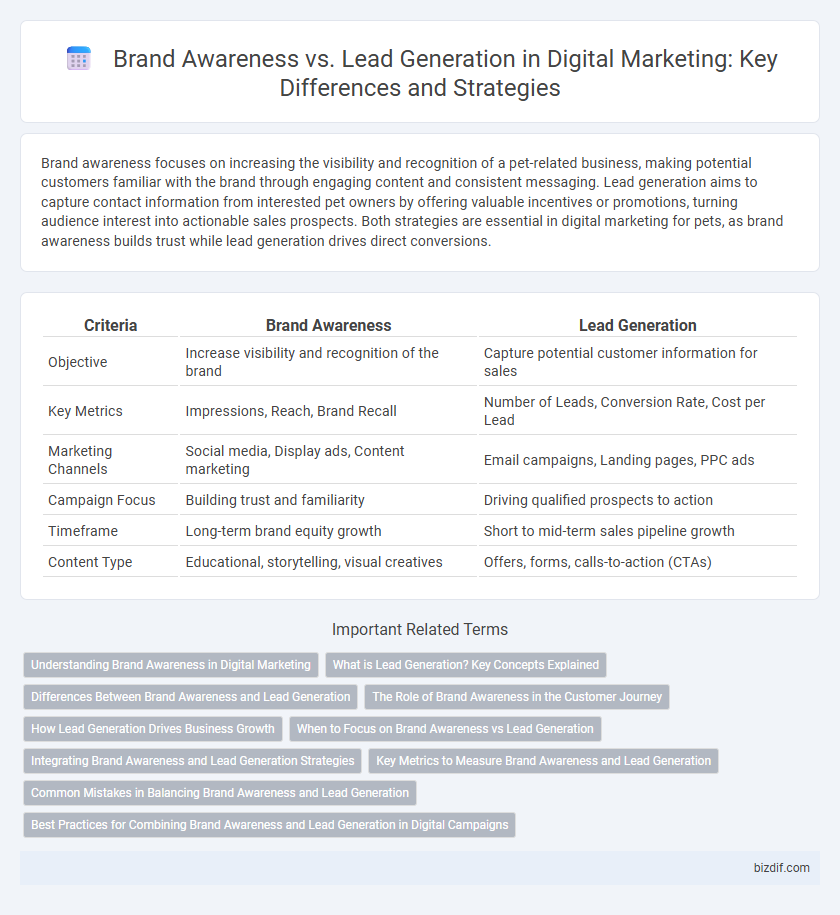Brand awareness focuses on increasing the visibility and recognition of a pet-related business, making potential customers familiar with the brand through engaging content and consistent messaging. Lead generation aims to capture contact information from interested pet owners by offering valuable incentives or promotions, turning audience interest into actionable sales prospects. Both strategies are essential in digital marketing for pets, as brand awareness builds trust while lead generation drives direct conversions.
Table of Comparison
| Criteria | Brand Awareness | Lead Generation |
|---|---|---|
| Objective | Increase visibility and recognition of the brand | Capture potential customer information for sales |
| Key Metrics | Impressions, Reach, Brand Recall | Number of Leads, Conversion Rate, Cost per Lead |
| Marketing Channels | Social media, Display ads, Content marketing | Email campaigns, Landing pages, PPC ads |
| Campaign Focus | Building trust and familiarity | Driving qualified prospects to action |
| Timeframe | Long-term brand equity growth | Short to mid-term sales pipeline growth |
| Content Type | Educational, storytelling, visual creatives | Offers, forms, calls-to-action (CTAs) |
Understanding Brand Awareness in Digital Marketing
Brand awareness in digital marketing measures how familiar consumers are with a brand's identity and values through online channels such as social media, search engines, and display ads. It establishes trust and recognition, driving customer engagement and loyalty even before direct sales efforts begin. Effective brand awareness campaigns use targeted content and consistent messaging to position a brand prominently in the competitive digital landscape.
What is Lead Generation? Key Concepts Explained
Lead generation in digital marketing refers to the process of attracting and converting prospective customers into interested leads by capturing their contact information through targeted campaigns. Key concepts include landing pages optimized for conversions, lead magnets offering value in exchange for data, and tracking metrics such as cost per lead (CPL) and conversion rates. Effective lead generation strategies leverage content marketing, social media advertising, and email marketing to nurture potential customers through the sales funnel.
Differences Between Brand Awareness and Lead Generation
Brand awareness focuses on increasing recognition and recall of a company's name or products among a broad audience, aiming for long-term customer loyalty and market presence. Lead generation targets capturing specific potential customer information to drive immediate sales or conversions through tactics like gated content, landing pages, and targeted ads. While brand awareness builds trust and emotional connections over time, lead generation emphasizes measurable, short-term results essential for sales funnel progression.
The Role of Brand Awareness in the Customer Journey
Brand awareness plays a critical role in the customer journey by establishing trust and recognition, which increases the likelihood of conversions during the lead generation phase. High brand awareness improves customer recall and influence at the consideration stage, making targeted lead generation efforts more effective. Investing in brand awareness campaigns boosts long-term engagement and drives sustained lead acquisition, enhancing overall digital marketing performance.
How Lead Generation Drives Business Growth
Lead generation transforms interested prospects into potential customers by capturing their contact information and nurturing them through targeted strategies, thereby accelerating sales pipelines. Unlike brand awareness, which broadens visibility and recognition, lead generation delivers measurable ROI by directly contributing to revenue growth and customer acquisition. Implementing data-driven lead generation campaigns enhances customer targeting, optimizes conversion rates, and supports sustained business expansion in competitive digital markets.
When to Focus on Brand Awareness vs Lead Generation
Focusing on brand awareness is essential during the early stages of a marketing strategy to establish recognition and build trust among target audiences. Lead generation becomes more critical once brand credibility is established, aiming to convert interested prospects into qualified leads for sales. Market maturity, campaign goals, and budget allocation typically guide the decision between prioritizing brand awareness or lead generation efforts in digital marketing.
Integrating Brand Awareness and Lead Generation Strategies
Integrating brand awareness and lead generation strategies amplifies overall marketing effectiveness by creating a cohesive customer journey from recognition to conversion. Brand awareness campaigns utilize content marketing, social media, and influencer partnerships to build trust and visibility, laying a foundation for targeted lead generation tactics such as gated content, email marketing, and retargeting ads. This synergy not only increases qualified lead volume but also enhances lead quality by attracting prospects already familiar with the brand's value proposition.
Key Metrics to Measure Brand Awareness and Lead Generation
Key metrics for measuring brand awareness include reach, impressions, and social media engagement, which reveal how well the target audience recognizes and interacts with the brand. Lead generation effectiveness is quantified through conversion rates, cost per lead (CPL), and the number of qualified leads, indicating the success of campaigns in attracting potential customers. Tracking these metrics enables marketers to optimize strategies, balancing broad exposure with targeted customer acquisition efforts.
Common Mistakes in Balancing Brand Awareness and Lead Generation
Neglecting consistent messaging across channels can dilute brand identity, making lead generation efforts less effective. Overemphasizing immediate conversions often sacrifices long-term brand loyalty and recognition, limiting sustained growth. Failing to integrate analytics for both brand awareness and lead generation campaigns leads to missed opportunities in optimizing marketing strategies.
Best Practices for Combining Brand Awareness and Lead Generation in Digital Campaigns
Combining brand awareness and lead generation in digital campaigns requires targeting customized content that resonates with audiences at different stages of the buyer's journey while leveraging data analytics to optimize performance. Utilizing multi-channel strategies such as social media advertising, search engine optimization (SEO), and retargeting ensures broad reach and effective conversion, enhancing both brand visibility and lead quality. Employing A/B testing and marketing automation tools streamlines campaign adjustments, maximizing return on investment (ROI) by aligning messaging with user intent and engagement patterns.
Brand Awareness vs Lead Generation Infographic

 bizdif.com
bizdif.com